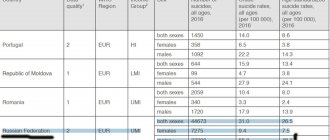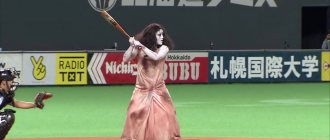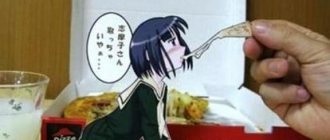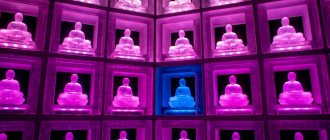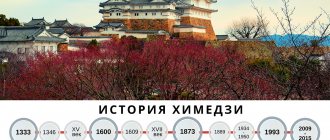Japan is a country of new technologies, anime and quirky traditions. Every year millions of tourists visit this interesting country. But there is one place that cannot be found in any excursion program. This place is the Aokigahara forest, or as the Japanese call it, Jukai (“sea of trees”). The forest is located on the island of Honshu at the very foot of Mount Fuji.
Description of Aokigahara
The date of the appearance of the Aokigahara forest is considered to be 864. It was then that a powerful eruption of Mount Fuji occurred, which resulted in the formation of a lava plateau with an area of 40 square kilometers.
The soil of the forest looks as if some unknown force was trying to uproot the huge trees. Knotty, intricately intertwined tree roots come out, unable to break through the lava rock. The relief of Jukai is covered with many caves and crevices, the length of which can reach hundreds of meters.
The forest area is more than 35 square kilometers. Aokigahara is a fairly young forest, as it was formed about 1200 years ago. In 1707, the last significant volcanic eruption was recorded, but due to some strange circumstances, one of the slopes of Fuji was not covered with lava. The 3,000-hectare site was soon overgrown with dense coniferous forest.
Now the Aokigahara Forest is a national park, and its close location to the capital allows tourists to conveniently explore all the sights and routes of the forest. Visitors to the park are offered to climb Mount Fuji and walk through a delightful forest area, visit ice and windy caves.
The dense crowns of Aokigahara trees do not allow daylight to pass through, and external sounds do not reach people. The silence immediately “cuts the ear” of the tourist who enters. It is worth noting that the air in the forest is terribly stale, and the temperature inside Jukai is significantly lower than the surrounding one. Such a pressured environment has a very detrimental effect on the human psyche, creating the impression that someone is watching from the outside.
Experts believe that in the depths of the forest there are large deposits of iron ore. Apparently, this is precisely the main reason why compasses do not work in the forest.
Aokigahara, according to the Japanese, is their sad landmark. It is often called the “suicide forest”, and mythology says that it is home to ghosts and demons.
Legends of Aokigahara
The legends of Aokigahara are known to every resident of Japan. During the Middle Ages, Japan experienced severe food shortages and the population was starving and suffering. It was during this difficult time that the custom of ubasute gained wide popularity. Its purpose was to bring children and old people further into the forest. Poor families who were unable to feed their loved ones left them there to die a painful and terrible death.
The unfortunate people left to die cursed those who treated them so cruelly until their last breath. The souls of the deceased “prisoners” of Aokigahara were filled with anger and obsession with revenge. The Japanese call these souls yurei. They say that the spirits have long thin arms, a body without legs, and their eyes glow with red fire. Yurei walk aimlessly through the forest, emitting sad moans.
Travelers who decide to visit Aokigahara must have very strong nerves. Often, a crunching branch underfoot may turn out to be a human bone, and the outline of a body in the distance may be the corpse of another hanged man.
The sad story of the forest
Photo: Richard Atrero de Guzaman
The forest of suicides gained notoriety back in the Middle Ages. Many poor people were unable to feed a large family, so they brought sick and old people unable to work into the forest and left them to certain death. It is said that their restless souls have turned into evil ghosts that wait in the forest for lonely wanderers to avenge their torment. Walking through the forest at night, you can hear the moans and even screams of these ghosts. Do you think this is just a wild imagination?
Suicide Forest (Aokigahara)
Aokigahara is a place of pilgrimage for hundreds of people who have decided to commit suicide. According to this terrible indicator, Jukai ranks second in the world (first behind the Golden Gate Bridge in San Francisco).
Aokigahara is popular among suicides thanks to the works of Wataru Tsurumi: “The Complete Guide to Suicide,” which was published in 1993. The book immediately becomes a bestseller (more than a million copies sold). The book gives a variety of ways to “pass away from life”, and the Aokigahara forest is indicated as a “wonderful” place for this. Even now, near some of the bodies of suicides, the police find copies of Tsurami’s creations.
Since 1970, the Japanese police began to officially search for and identify the corpses of suicides. According to statistics, up to 100 bodies are found in Aokigahara every year, and their number increases every year. The most popular methods of suicide include hanging and drug poisoning.
Some eyewitnesses say that if you go even a couple of meters deep into the massif, you can find many bags, bottles and medications of suicidal people.
Suicide prevention
In order to prevent suicides, local authorities are taking many different preventive measures - installing video cameras on the approaches to the forest and hanging signs asking people to come to their senses. The content of the call is as follows:
“Your life is a priceless gift that your parents gave you. Think about your family. You don't have to suffer alone. Call us. 22-0110"
To reduce the incidence of suicide, local stores do not sell ropes or strong drugs, as these are the most commonly used means of suicide. Employees of stores located near the forest can confidently say from their own experience who the future suicide is. According to them, these are the people who walk for a long time near the paths leading to the forest, they do not meet anyone’s eyes and do not raise their heads. At the slightest suspicion, store employees immediately report the arriving “tourists” to the local police.
Volunteers often come to help the police. Together they patrol the forest area and nearby roads to prevent an increase in suicides. Once a year, Aokigahara undergoes a full inspection. In addition to the police, up to five thousand volunteers participate in it. Inspected areas of the forest are fenced off with tape.
Mysterious remains. Ribbons. Aokigahara Jukai Forest, stay on the trail! 16+
Attention! The post contains violent and shocking images. Sensitive and faint of heart people should refrain from watching.16+
Aokigahara Jukai is a dense, dense primary forest. extending to the foot of Mount Fuji, which is also the Reizan World Heritage Site of which Japan is proud. This is an area that can be called part of Mount Fuji. Jukai was caused by the eruption of Fuji 貞大, which occurred in 864.
The lava that erupted during the eruption flowed down the north side of the mountain. This forest has an area of 35 square meters. Km is cold, rocky and contains about 200 caves, some of which, such as the Ice Cave and the Cave of the Winds, are popular with tourists.
Tourists from the USA love this forest.
The forest is a popular place for walking, jogging and picnics for many people, but in Japan the situation is different. Aokigahara no Mori, located at the foot of Mount Fuji, is the most famous suicide site. Since the 1950s, the number of reported suicides in the forest has been increasing at a rate of 10 to 30 per year. In 2003, a record 105 suicide victims were found here. According to police, in 2010, 247 people attempted suicide in the forest, but only 54 of them “succeeded.”
September 1st, the main day of suicide among children in Japan
It is also known as the second most common suicide site in the world. The most common location is the Golden Gate Bridge in San Francisco, California. It is difficult to get an average profile of those who commit suicide in the forest, but they are usually men between 40 and 50 years , and the most popular month for suicide is March, perhaps because March is the end of the fiscal year in Japan. So many people come from all over Japan to end their busy lives here as they feel it is the perfect place to take their last breath.
“For the Japanese, suicide is not a mortal sin, as it is for Christians.”
Aokigahara no Mori, where between 50 and 300 suicide scenes occur annually, is considered a place where evil spirits reside, according to Japanese mythology. The forest is known today as "jukai", which means "sea of trees".
A local police officer said: "I saw a lot of bodies that were really badly decomposed or had been eaten by wild animals... There's nothing wonderful about dying there."
The forest has a historical reputation as the "home of yurei": the ghosts of the dead in Japanese mythology. In recent years, Aokigahara has come to be known as the "Suicide Forest", one of the most commonly used suicide sites in the world. Signs at the beginning of some paths encourage suicidal visitors to think about their families and contact the Suicide Prevention Association.
“One of the Japanese terms for suicide is “jiketsu,” which means “decide for yourself.”
According to Japanese folk belief, if a person dies in deep feelings of hatred, anger, sadness or a desire for revenge, his soul cannot leave this world and continues to wander, appearing before the people affected by the spell or those whom he met in life. These souls are called yurei, and references to them can be found in many modern cultural sources such as films. Unlike Western horror films, where the ghost wants something specific in order to be able to rest in peace, yurei don't want anything specific; they just want their curse to be lifted or their conflicts resolved.
Legends about ghosts are not without foundation. In medieval Japan, the custom of ubasute was practiced, when poor families during famine took old people and children into this forest, whom they could not feed and left there to die. Until their last breath, the unfortunate people cursed those who abandoned them in the middle of the forest alone to certain death, and their souls, possessed by malice, became eternal prisoners of Aokigahara.
Japanese spiritualists believe that suicides committed in the forest entered the trees of Aokigahara, causing paranormal activity and preventing many who entered from escaping from the depths of the forest. Further complicating matters is the common experience of compasses being rendered useless by the rich deposits of magnetic iron in the area's volcanic soil.
“My will to live was gone,” Taro, a middle-aged man, told CNN in 2009. “I lost my identity, so I didn’t want to live on this earth. So I went there.
Many trees of different types in the forest turn the atmosphere into a kind of closed space. As a result, you cannot hear external sounds in the forest, and you cannot hear internal sounds outside. The tree cover is so dense that even at midday there is hardly a bright spot in the forest.
Since 1999, more than 30,000 people have died from suicide each year in Japan. Of particular note is that the suicide rate among children has increased significantly. The suicide rate among young people under the age of 19 is increasing by approximately 25% every year. About 100 people in Japan die by suicide every day. This number is four times the number of people killed in road accidents. Among industrialized countries, Japan has the highest suicide rate. By the way, in the USA the suicide rate is only half of those killed in the land of the rising sun.
Even during the feudal era in Japan, suicide was considered an act of honor. Samurai warriors would rather commit suicide, known as seppuku, than fall into the hands of the enemy - a way to protect their honor and dignity. Even during World War II, soldiers who joined the Kamikaze, the Special Strike Force, making sacrifices for their country were considered respected and revered. These days, many people choose to commit suicide not for good reasons, but mainly because they cannot fit into society.
Rising suicide rates among children in Japan
When the forest became known as a suicide spot, the Japanese government immediately addressed the problem. At the entrance to the forest, a sign appeared with the inscription: “Your life is a priceless gift from your parents. Think about them and your family. You don't have to suffer alone. Call us"
Many urban legends surround this forest, and some believe it is haunted due to its tragic history
“Please consult this phone number before deciding to commit suicide.”
Local authorities have installed CCTV cameras at the entrance to the forest, hoping to track those entering. This does not deter determined people from committing suicide in this dense forest. Every year, volunteers clearing the forest find dozens of corpses, but many are lost forever in the very dense forest. Japanese authorities have stopped publishing accurate data on suicides to prevent the site from becoming even more popular.
The forest is the place of choice for Japanese people to commit suicide.
Although this mysterious atmosphere has existed for a long time, this forest became famous and fashionable again under the influence of Seich Matsumoto's novel "Black Jukai" ( Black Sea of Trees ). It describes the sad story of the suicide of two unhappy lovers who took their last walk in the forest. Contemporary news outlets have noted a recent spike in forest suicides, blaming them more on Japan's economic decline than on the novel's romantic ending.
You can also often find wills left by suicides in this forest. For example, in one of the wills written on a tree there are the following words: “I came here because I have nothing left to do with my life.” Three decades ago, a Japanese psychiatrist who interviewed several Aokigahara suicide survivors wrote that the main reason was that “they believed they could die successfully without being noticed .
There were many people who were actually lost or lost. It couldn't be easier to get lost in a place like this. The forest guard says three types of visitors to Aokigahara Jukai can be immediately identified by local residents.
- People who hear rumors about this forest for the first time and come to see what this place is all about.
- Then there are people who go hiking to see Mount Fuji from different angles.
- The third is people who do not think of leaving the forest; they are asked to report these people to the police.
Once a year, a cleanup day is held in the forest. A large group of volunteers (up to 300 people) and police are “cleaning the forest” of corpses and remains of bodies.
According to some reports, forest workers must bring the remains from the forest to the local police station, where they are placed in a special room designed specifically to house dozens of corpses of suicide bombers from this damned forest.
Some Japanese believe that leaving a corpse alone is a great bad luck for the yurei (ghost) of suicide victims. It is said that their spirits scream all night, and that their bodies will move on their own.
The entrance to the forest is full of abandoned cars.
The owners of this car entered the forest, never to return. The most popular way to commit suicide is hanging or poisoning with medications. There are often cases of suicide by conspiracy, when a couple in love, who cannot be together for various reasons, passes away at the same time. The police, having discovered such a “couple,” do not even conduct an investigation, considering what happened to be obvious.
Many suicides or tourists buy ribbons or ropes that they tie along the trail when going into the forest, so that they can return.
Guards say the tapes are intended for those who are afraid of getting lost (or having second thoughts about killing themselves) when entering the forest. Unfortunately, no one knows whether these people left the forest.
Currently, hiking trails have been built through the entire Jukai Forest. This is to protect precious nature and also to protect human life. Be careful not to go off the trail.
Logan Paul. “It’s part and parcel of the great American fascination with Japan.”
In January 2021, the forest attracted international attention after an American YouTuber filmed and broadcast the body of a suicide victim on his popular channel. Stupid laughter, American jokes, mockery of the deceased caused a serious scandal. The video received widespread backlash for its salacious treatment of suicide and mental health in a country where suicide rates are higher than most developed countries.
If you visit this place, please be respectful if you encounter suicide victims. Contact local authorities so they can handle the situation appropriately. This is a dark place, the death of others should not be taken lightly, even if you are an American.
Aokigahara has been referenced in several media, including anime and manga, films, literature, music, and video games.
It was the subject of a BBC Radio 4 program (first broadcast 10 September 2018) in which four poets traveled to Aokigahara to write and record poetry in the forest.
Most recently, the 2021 American horror film The Forest features a woman who goes there in search of her twin sister, who has mysteriously disappeared into the forest.
Poets Arai Takako, Jordan A.Yu. Smith, Osaki Sayaka, and Yotsumoto Yasuhiro co-authored a bilingual (Japanese-English) anthology of poetry and short essays about Aokigahara entitled Sea of Trees: A Poetic Gateway to Aokigahara (ToPoJo Excursions, 2019)
Japanese American playwright Christine Haruna Lee wrote and directed the play Suicide Forest in New York City in March 2019. It talked about suicide in America and Japan, referring to the Aokigahara forest.
The 2015 film The Sea of Trees, starring Matthew McConaughey, Ken Watanabe and Naomi Watts, also tells a story set in this forest.
The number of suicides in Aokigahara Jukai is not disclosed by order of the Japanese government. The goal is to dispel the image of the forest and at least slightly reduce the suicidal ideation of the population.
If you're interested in hiking in the forest, it's located about two hours west-southwest of Tokyo. Available without a car. You need to take the Fujikyu train to Kawaguchiko Station, then take a retro bus. Entrance from the parking lot to the cave of Lake Sai Bat.
Views: 5,598
Share link:
- Tweet
- Share posts on Tumblr
- Telegram
- More
- by email
- Seal
Liked this:
Like
